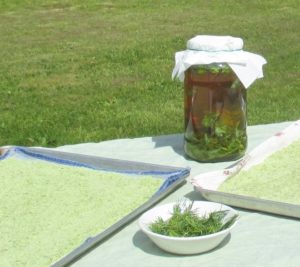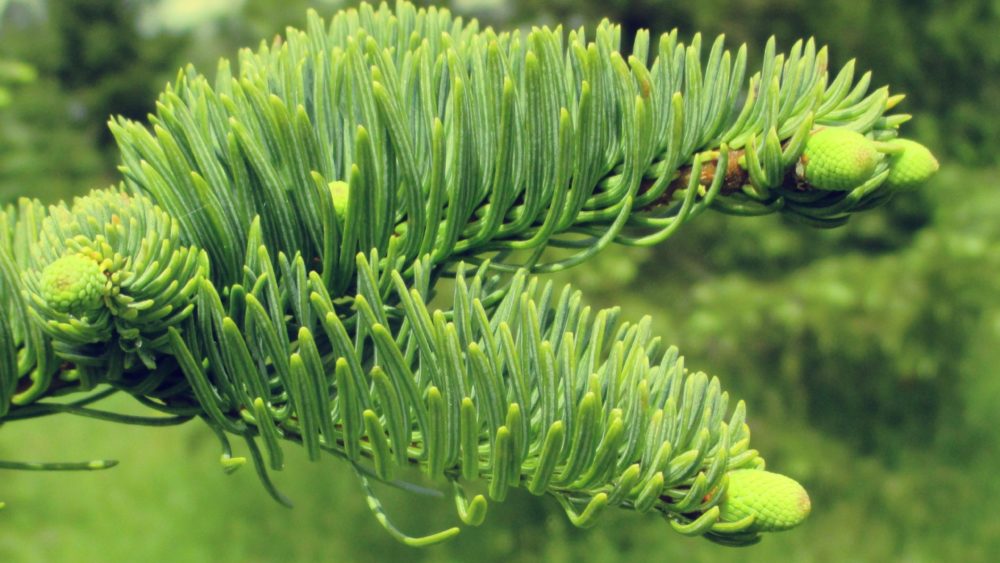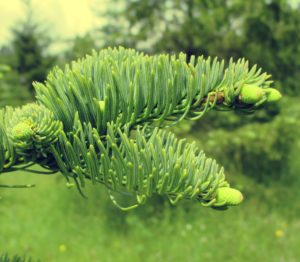When you think of foraging in the woods, most people look to the forest floor and low growing shrubs and bushes for food and medicinal plants. But there is so much more to be had! The next time you are out in the woods, why not look up? Look to the trees, specifically the evergreen trees. This is the season for harvesting the bright green spring shoots for food and medicine.
All the evergreens are edible – fir, pine, spruce, cedar, with the exception of yew which is a poison and should not be consumed.
Evergreen trees are an amazing source for just about anything you can think of – including the obvious requirements for shelter and shade, but also for your pantry and pharmacy needs. Indigenous people around the world have used various parts of conifer trees for centuries, not only as building and food sources, but also for medicine. In the spring, the tender bright green tips were added to their diet in the form of teas from the needles, and the liquid from boiling branches was a natural cleaner and air freshener for their dwellings. Some call it the original Pine Sol!
This ancient knowledge is validated today by modern science. The tender young tips of evergreens trees are an excellent source of vitamins A and C and are rich in potassium and magnesium. They are also great immune boosters and can relieve coughs and sore throats as the volatile oils and resins in these tips have antimicrobial, antibacterial and antioxidant properties. It has also been suggested that the abundance of chlorophyll the tips contain help with speeding up tissue healing and when ingested, keeps blood sugar in balance and helps to flush out poisonous metals from the tissues.
All in all, evergreen trees are a natural pharmacy.
WHEN AND HOW TO FORAGE
Depending on where you live, early spring is the best time to forage for the tender green tips. And remember, there’s still snow in higher elevations, so if you miss the harvest at lower elevations then go up higher and the green tips will still be fresh and tender.
Practice the 100 metre rule by foraging at least 100 metres from any roads and make sure you are not down wind or downstream from sources of pollution like smokestacks or tailings ponds. Pick only the tips without the papery covering. Picking the tips is also a form of pruning, so be mindful of how many tips you pick from any one branch or tree.
(Note: the 100 Metre Rule should be applied anytime you are out foraging).
ENJOY THE FRUITS OF YOUR LABOUR
These delicate tips can be made into syrups, used in baking, in smoothies, soups and stews, and used as a dry rub ingredient. The possibilities are endless. One of the easiest ways to enjoy the tips is simply a cup of refreshing Evergreen tea.
The following recipes are thanks to herbalist, Rosalee de la Forêt for some of these recipes
Simple Evergreen tea
Use fresh bright green tips for this refreshing drink. Put a small handful of evergreen tips into a tea pot or French press and pour over 2 – 3 cups of boiling water. Put the lid on to trap the steam, so that it condenses and drops back into your pot. Steep for 10 minutes and sweeten with honey as desired. Add a sprig of mint, lemon balm or holy basil for added flavour, or a pinch of cinnamon, cardamom or other aromatics. This can also be made extra strong, cooled off then diluted with sparkling water for a refreshing beverage on a warm day.
Simple Evergreen sugar syrup
Dissolve 1 cup of sugar in 1 cup of water and stir in ½ cup of chopped evergreen tips. Keep warm for 15 minutes, but do not let it scorch. Remove form heat, cool a little, strain out the herbal material and pour off into a clean bottle. This will keep for up to a week in the refrigerator. Use 1 – 2 tsp. to add to any beverage or dessert.
Douglas Fir & Mandarin Bitters
- 30 grams fresh Douglas fir needles
- 30 grams dried roasted dandelion root
- 5 mandarins sliced up (peels included)
- 1 gram or 1 teaspoon dried gentian root
- 1/4 cup honey
- vodka or brandy
Put the herbs and fruit into in a 1.5 L jar.
Add honey to taste.
Fill the jar with the vodka or brandy. Stir well. Cover with a lid. Label. Shake this 1 to 2 times per day. Taste this daily. When the flavours have infused to your liking, strain off the herbs, reserving the alcohol.

We flavour vinegar using spruce tips and the tender needles of cedar to make flavoured salts. Both products are available through our online Innisfree Farm Shop.
Store in a dark bottle or dark location. Use within a year.
With this recipe you can bring a bit of the forest inside. This simple scrub will leave your skin feeling super soft and deeply moisturized. This is a wonderful way to protect your skin from that dry and harsh winter weather.
- 65 grams shea butter
- 45 grams coconut oil (
- 3 Tablespoons olive oil
- 2 Tablespoons minced conifer needles
- 40 drops Fir Needle essential oil (Abies balsamea)
- 20 drops Scotch Pine essential oil (Pinus sylvestris)
- 10 drops grapefruit essential oil (Citrus paradisi)
- 1/2 cup salt (150 grams)
Melt the shea butter and coconut oil on low or in a double boiler. Remove from heat.
Add the olive oil and needles. Add the essential oils and stir well.
Let cool until it becomes solid. If you leave this on the counter this can take up to five hours. If you put it in the fridge or the cold outdoors it takes considerably less time. Once it is solid (but still soft), use a rubber spatula to transfer the mixture to a food processor or blender. Blend on high until the mixture becomes thick. Using your spatula, transfer the mixture into a medium sized bowl. Gently stir in the salt.
Place the salt scrub into a small container with a lid that can be kept in the shower.
This salt scrub will keep for a very long time. I recommend using it up within 6 months.
Makes roughly 1 cup of salt scrub.

